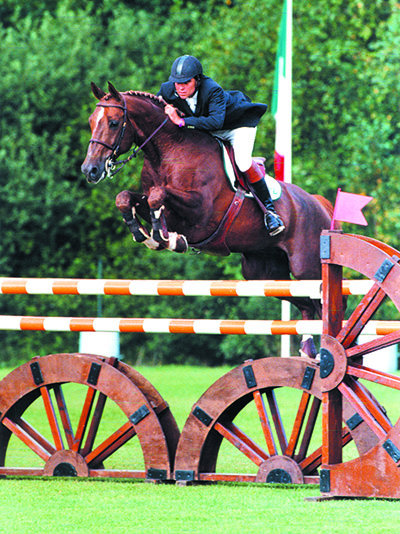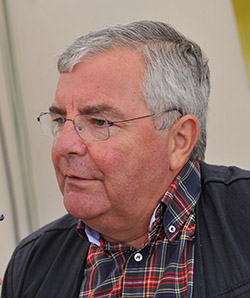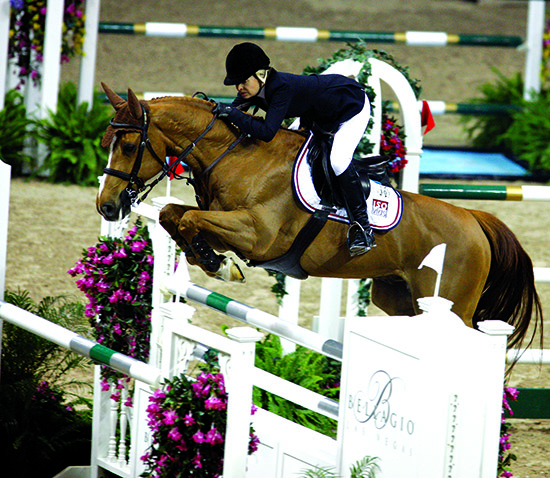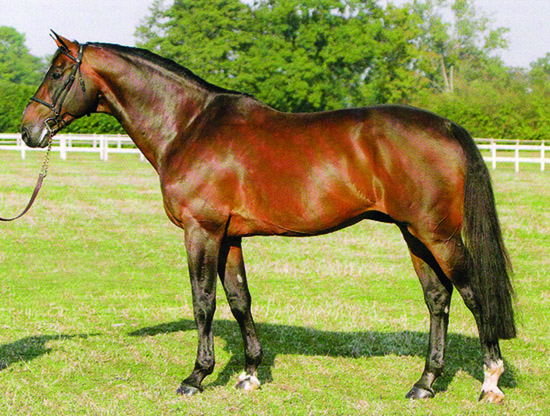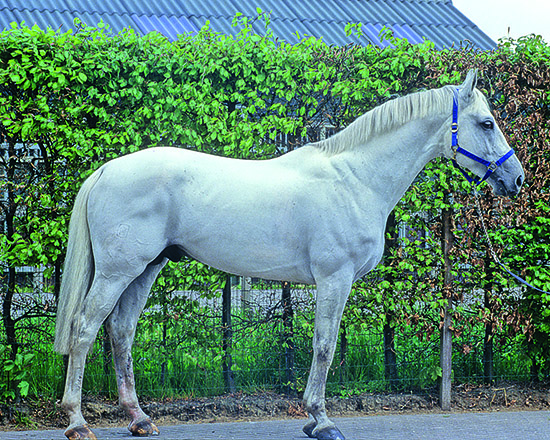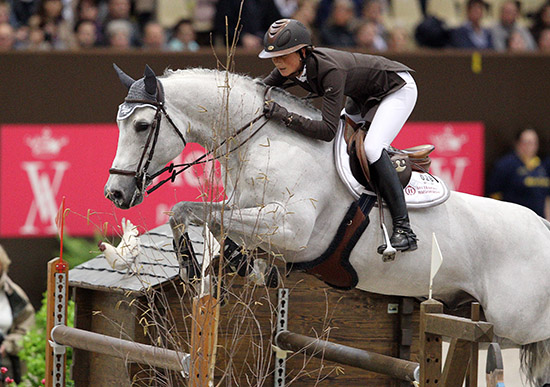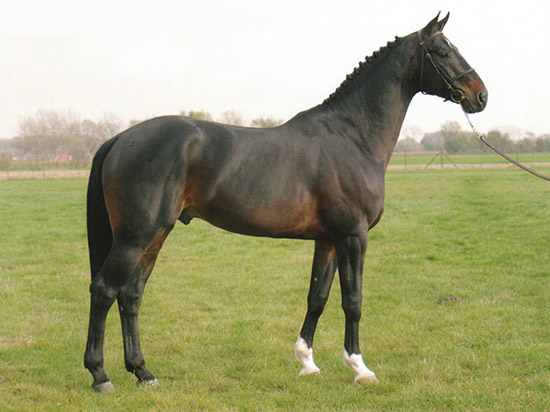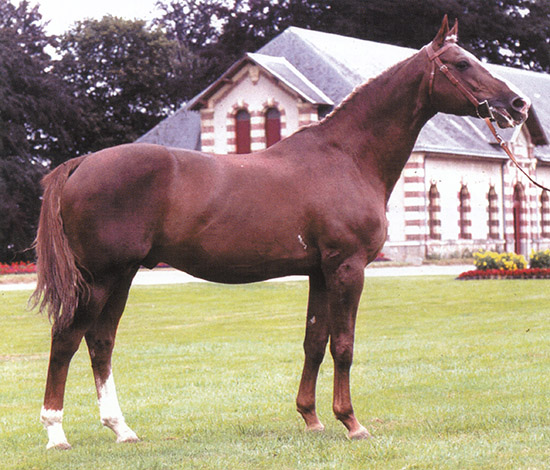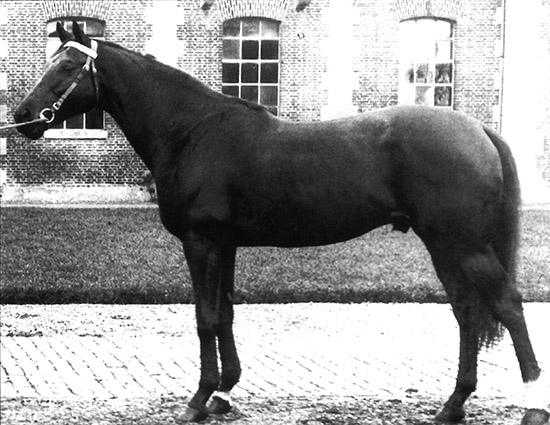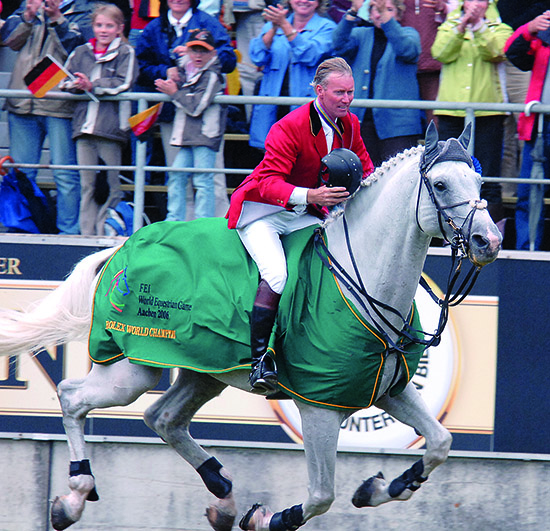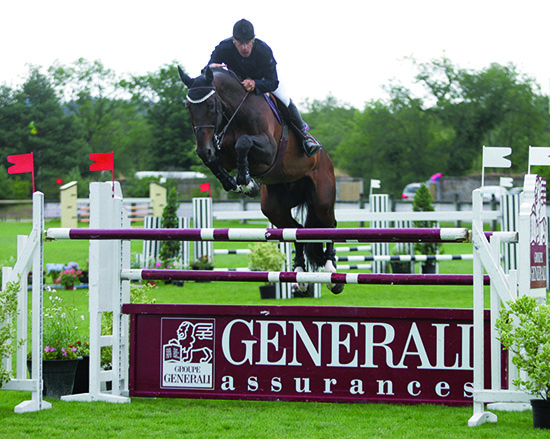The view in 2007:
The Selle Français studbook started to open the window just a fraction to foreign stallions in 1988, when the Silver medallist in the showjumping at the LA Games, the Trakehner, Abdullah, was allowed to breed a few mares (one result was Cabdullah, a successful stallion out of Jalisco’s full sister). Then the stud book was opened just a little wider to allow ‘dressage breeding’, Donnerhall semen was imported, and then Arnaud Evain persuaded the keepers of the studbook that Voltaire would improve dressage capabilities, so he was allowed also – but only for 15 mares.
Cabdullah due Tillard – half German, half French, the door is half open…
The Studbook was burst open in 1994 with the rules on free trade within the European Common Market, and in the 90’s the prime position of the State Stud began to be challenged by private stallions who were successful both in competition, and in breeding. During this time, the National Stud mainly stood sons and grand-sons of the best private stallions – Almé, Laudanum, Jalisco B, Galoubet A, Le Tot de Semilly, Narcos II, Voltaire, Quidam de Revel, Quick Star and so on. At the same time private semen dealers (PHI, Haras de Brullemail, then Haras de Beligneux) started to import the frozen semen of successful Dutch and German stallions.
To catch up, the National Stud (Haras Nationaux) started to buy a few foreign stallions: Damiro B, Damiro L, Airborn Montecillo, and Lord Calando.
Arnaud Evain of PHI has been influential importing semen from Holland into France. When I interviewed him in December, 2003, he looked at some of the changes that have taken place:
“Today the foreign stallions are 15% of the market, and 15% of the breeders are breeding something other than Selle Français. The grass is always greener outside…”
Which stallions?
“I chose to use Dutch stallions, because first of all my Dutch is far better than my German, and also I think the Dutch have already made a big step – they did not exist 40 years ago.”
“They mixed a bit of Thoroughbred, quite a lot German blood and French and a bit of Belgian, and they made a commercial success out of that. More importantly when you see the progeny of a German stallion in Holland you have a better idea of what he is going to produce with a French mare, than you do with a German stallion in Germany. Especially the Holsteiner – I don’t know much about the Hanoverian, and that is my fault – but there are not many Holsteiners that will go well with the French mares because the French herd of mares is very different from the Holstein herd. It is the same the other way, the most successful French stallions in Germany – I don’t think they would have been so successful in France.”
“If you see a stallion like Quick Star, he makes tremendous horses in Germany with Holstein mares, in France he makes more normal horses. Just be careful. When you have a nice cocktail and you say, it would be good to mix it with a bit a hot water, maybe the temperature will ruin the perfume of your cocktail.”
“If I see a pure Holstein in Germany I am still not sure about the stallion, but if I see him in Holland with Dutch mares, I am able to say to French breeders that he will work with this type of mare, but not with that type.”
“Burggraaf has been successful for us because we can say to breeders, avoid giving him to leggy mares, avoid giving him to mares with a sour back… breed him to that kind of mares and he will fit well.”
“If I import an Australian wine, then it has to be a special one. We have a lot of wine in France and it is nice to have a very good Australian wine – but it is not worth drinking a normal one. If I go to Germany or Holland as a breeder, I don’t want to use a normal stallion, I want one that is going to add something I didn’t have – and make me a new stallion so I can beat those Dutch people in the next generation.”
“Concorde is an interesting stallion for us, he brings qualities that are useful in the French mares – agility in the hocks, activity behind. The two major qualities we have to improve in the French horse, is a bit of a better mouth and looser gaits. Sometimes our horses get contracted easily. That is why we are using imported blood – plus we like to follow the fashion, breeders have to sell foals. If they want For Pleasure because it will sell well, then I will get them For Pleasure – even if I think there are twenty horses in France at least as interesting as For Pleasure.”
“Partly we follow fashion, partly we try to add value to the French herd by using stallions that are known for their progeny. If we have to take a risk on a young stallion, we’ll take a risk on a young French stallion because we know more about his mother line.”
“It’s difficult because it is a mix between the technical attitude of improving the genetics, which only counts for 20% of the final result – and the commercial attitude which says a baby by this stallion will sell well because the owner will buy it back. A lot of breeders are thinking, not who will ride my foal, but who will buy my foal, and that is a short term attitude – we must breed horses to be ridden.”
France has been a pioneer when it comes to using frozen semen – what is the proportion of frozen used today?
“About 30% with frozen semen, 40% chilled and 30% natural service – old fashioned but it works, but it is going less and less.”
The stallions, are they state owned or privately owned?
“55/60% private – 35/40% national stallions. The National Studs have a policy of buying very good young stock and they have a very good network, right around the country, and they don’t make the breeder pay the right price, it is a pretty good argument for using those horses – good horses spread all over the country and at half the price they should cost.”
Do the French breeders breed for the amateur or elite market?
“They breed for the Olympics and sell to whoever wants to buy. That’s our Mediterranean temperament. More and more are breeding for a rideable horse. That was my interesting problem in the young horse classes I judged in Australia – should I give a better score to the one I would recommend Edouard Couperie to come and look at for the next World Cup, or to the one which is going to make the nicest 1.40 for an amateur? Which do you think? If you ask for the horse for my daughter to ride, or for Edouard to ride – they are both good clients – but the selection is not the same.”
“To bridge this gap we are trying to create a 1000 day program, where an amateur can buy a three year old and brings him up to being a nice six year old, with the help of a professional for one week every month. This is a program where they can, phase by phase, build a horse. It is much too expensive to have an amateur horse made by a professional rider. An amateur likes to have a horse they can do something with… 80% of the competition is amateurs, people who only ride twice a week.”
And like the rest of Europe, are auctions the place to buy a young horse?
“Auctions are not so bad. Altogether there are about 750 horses a year sold in French auctions, so that is about 10% of the births, so what goes to the auctions is within the top 25% of horses of the highest quality. If you want breeding stock you will probably find them at an auction. But go in a professional way, go to see the horses at the stable, watch the vets’ reports, if you do all that properly then the auction is the best way to make a good deal – but you have to be professional. You have to make a decision, I have this budget, up to this amount I will go and no further – we as auctioneers will try, ‘come on 10% more and you will have it’. We are helping the breeders sell their horses… but the rest of the year we are saying to the breeders, put a low reserve price to help us sell. We love our breeders and we love our clients. It is consistent in our auctions over the last ten years, I write down the price I think the horse will go for and 60% of the time I am right, when I am wrong it is equally 20% higher, 20% lower. That is why a sale is a good chance for everyone, but more for the person wanting breeding stock, or a professional.”
Itot du Chateau (Le Tot du Sémilly / Galoubet) – sold at Arnaud’s Fences Auction…
Do you get X-ray reports at a French Auction?
“Of course. Too many, sixteen per horse.”
Is OCD a problem?
“It is a large opportunity for the veterinary profession to make money. OCD is a problem, but we lived with OCD at a fairly high level until we discovered how to read it on the x-rays. We now know quite well how to fix it. Less than 20% of OCD cases become a problem, and in the majority of those situations, surgery can fix the problem.”
“Back in the 70s we were talking about navicular, but thanks to the farrier, thanks to our feed suppliers and our vets, we have been able to live with that. If OCD had been a key point in the selection, you would never have heard of Ramiro, never heard of Almé, nor of Jalisco or any of those good stallions.”
Are stallions in France rejected on the basis of their x-rays like they are in Holland?
“No – and the Dutch will abandon that system eventually, it is just marketing. The Dutch will privately tell you that they are missing some good stallions because of this system. In France it is included as part of the information about the stallion, that is a must, and you must give the mare owner the OCD score of the horse. We can deal with OCD like we dealt with navicular. If you have a foal from a stallion that has OCD in both stifles then you must be careful with how heavy you let that foal become, that is the risk, but the day you give up taking risks, you give up breeding. Looking for a horse with no faults, you will end up with a horse with no quality. There are no miracles in this business of breeding, be pragmatic, be passionate and keep your eyes open.”
Diamant du Sémilly – France’s No 1
Looking at the most popular stallions in France for 2006, we see that the ‘foreigners’ are well and truly established. The most used private stallion was the solidly French, Diamant de Semilly with 260 mares, but the second most popular was Opium de Talma – half and half – by Carthago out of a Qredo de Paulstra mare (233 coverings). In third place, we have the Holsteiner, Calvaro by Caletto I out of a Capitol mare with 227 mares. The grey Dutch stallion Mr Blue is next with 210 mares.
Mr Blue in 4th…
Mr Blue is by Couperus, a stallion the Dutch presented to the Indonesians, before they realised what an excellent sire he was to be. Mr Blue was out of a granddaughter of the Anglo Arab, Inschallah.
Fifth place to a Holsteiner with a French sire: Quincy (alias Quaprice) by Quidam de Revel out of a Lord mare (200 mares). Sixth, the solidly Dutch bred Kannan (Voltaire / Nimmerdor) with 182 mares. Seventh, Cardero (alias Champs Elysees) another Holsteiner – by Coriano out of an Ahorn Z / Caletto I dam, with 157 breedings. Eighth, Otto Mail, a curious mix, by Weltmeyer out of a French jumping bred mare by the American Thoroughbred, Hand in Glove. He covered 136 mares. Ninth, the French bred Jarnac (Ryon d’Anzex aa / J’T’Adore) with 129 mares and rounding out the top ten, the Dutch bred World Cup star, Tinka’s Boy (by Zuidpool out of a mare by the French Anglo-Arab, Zeus) who covered 112.
When we look at the top ten State Stud Stallions, it is a similar story. Although eight of the top ten are described as Selle Français with a lone Anglo Arab and only one foreigner, Robin Z II (branded a Hanoverian) there is a fair proportion of outside blood in them however French their brands. Robin Z II’s popularity was not to last, the following season – 2007 – saw him cover just 13 mares!
Mylord Carthago – the most popular State Stud Stallion of 2006
The most popular stallion on 2006 was Mylord Carthago, a nicely balanced mix of German and French lines being by Carthago out of a Jalisco B mare with 307 breedings.
Second, another German / French cross, Luccianno (Burggraaf / Almé) with 254. Third to Flipper d’Elle – solidly French, Double Espoir / Jalisco B – 227 mares. Fourth, Allegreto (Jalisco B / Uriel) on 187. Fifth, Apache d’Adriers (Double Espoir / Felix) with 183 mares. Sixth, Easy Boy (Nidor Platière / Narcos) – 180. Seventh a Dutch / French duet, Oncle Pol (Kannan / Narcos) – 142. Eighth, the Anglo Arab, Laurier de Here (Veloce de Favi aa / Samuel aa) – 137. Ninth, Robin Z II (Ramiro / Almé) – 136. Tenth, Par Ixe (Fergar Mail / Nidor Platière) – 133.
In 2007 the balance was much the same. In his review of the Top 100 stallions on the basis of mares covered in the Monneron 2008 / 2009, Bernard le Courtois remarks: “One sees that the majority of these stallions are undoubtedly SF (Selle Français): 48% are SF by an SF sire, 13% are SF by a SE (Selle Etranger = non-French) sire, 6% are AA (Anglo-Arab) and we could also take into account the 6% who are SE but by an SF sire. That gives a total of 74% of stallions with at least 50% French blood, or ¾ of them. We are far from the risk of ‘invasive’ foreign blood, brandished by certain protectionists.”
Half the ten most popular stallions in France in 2007 are Selle Français, but two of them are sired by Holstein stallions – on the other hand, two of the five foreigners were sired by the French stallion, Quidam de Revel.
Number one on the top ten list is Diamant de Semilly (Le Tot de Semilly / Elf III) with 398 mares, followed by Le Arc de Triomphe (Landor S / Pilot) – 307; 3. Mylord Carthago (Carthago / Jalisco B); 4. Flipper d’Elle (Double Espoir / Jalisco B) – 222; 5. Calvaro (Caletto I / Capitol I) – 216; 6. Quaprice ex Quincy (Quidam de Revel / Lord) – 211; 7. Apache d’Adriers (Double Espoir / Felix xx) – 193; 8. Quite Easy I (Quidam de Revel / Landgraf) – 182; 9. Lando (Lancier / Raimondo) – 179; 10. Luccianno (Bruggraaf / Almé) – 168. No’s 1, 2, 5, 6 and 8 are private stallions – the other half stand at the State Studs.
No 2 in 2007, L’Arc de Triomphe
At the 2007 Selle Français Days final, there were 81 Selle Français three year old colts presented as potential breeding stallions, selected over five qualifying rounds. These 81 colts represented 40 stallions.
Ibrahim remains the most influential founding sire, with 28 descendants or 35% of the total. Of these, 25% descend from the most successful Ibrahim son, Almé – including seven sons or grandsons of Galoubet, six by Dollar du Murier, six by Papillon Rouge, and four by Quidam de Revel.
Grand Vaneur – still influential
22% of the finalists descended from Grand Vaneur – most notably via Diamant de Sémilly who provided 15 of the candidates. The two great Thoroughbred founders, Furioso xx and Rantzau xx, were each represented by seven colts (9%) through sons or grandsons of Cor de la Bryère, Furioso II and Mexico.
Foreign stallions were responsible for 19 candidates. The most influential was the great Holsteiner, Landgraf, largely through his grand-son, L’Arc de Triomphe, who sired six of the young stallions. The blood of Ramiro flowed in four of them, three descended from Capitol, followed by two from another Holsteiner, albeit one who made his name in Holland, Nimmerdor, and one each from Darco, Mr Blue and the LA Games silver medal winning Trakehner, Abdullah.
It was a similar story with the two year olds. There were 71 candidates sired by 44 stallions. Again, Ibrahim had the greatest number of descendants with 26 (36%), 22 through the Almé branch of the family. Sixteen were grandsons, or great-grandsons of Jalisco B, of which 11 were sons or grandsons of Quidam de Revel – his son, Quincy (formerly, Caprice de Bois Margot) provided five from his first serving season. Three were from another Quidam son, Dollar de la Pierre. There were four sons or grand-sons of Galoubet, including two by Jeff d’Or (by Elf d’Or, a son of Qredo de Paulstra by Galoubet). The line of Double Espoir was respresented by two sons of Apache d’Adriers and there were two sons of Narcos II.
The next most important line was that of Grand Veneur with nine descendants (12.7%). Of these, three were by Diamant de Sémilly and two by Fidji du Fleury.
The great Thoroughbred sire, Furioso
Furioso xx had nine representatives, three by Kannan. Next comes another great Thoroughbred, Rantzau xx with five, four through his son, Cor de la Bryère.
Uriel is represented with three grandsons or great-grandsons.
There were also two colts from the Mourne xx line, through Obéron du Moulin and Alligator Fontaine, two from the Thoroughbred, Best Turn xx, through Jaguar Mail, and one from the Orange Peel lineage (via Muguet du Manoir and his son, Troupier).
There were 18.3% of the colts from purely foreign lines. The largest group – five – descended from Landgraf, three of which were sired by Lucciano HN. Capitol was represented by three – two by Cumano, and one by Chef Rouge.
Darco was represented by two grandsons, both by Parco, Ramiro by one son of Robin II Z, Abdullah by one son of Airborn Monticello, and Kostolany also with one son of Karamel de Lauture.
I am indebted for this analysis to Henry Brugier, whose survey The Paternal Lieneages of 2007 SF Stallion Candidates, appears in Monneron 2008 / 2009.
Not only were the ranks of the breeding stallions opened, but the famed Horse Week at Fontainebleau opened its administrative arms to welcome ‘foreign’ competitors. It is a move that have not been universally acclaimed. Writing in the 2008 / 2009 Monneron, Elisabeth Delinares observes:
“As European borders fell, the horse world followed the vast exchanges and opening of the market. The same went for the SHF classes, which opened to foreign horses, finals included in 2000 (at first only for stallions, then from 2003 to mares and geldings.) Along with the Selle Français studbook, the very Francophile Big Breeding Week – designed as a showcase of French breeding twenty-five years ago, at a time when it must be said, chauvinism and protectionism were de rigeur, has taken on a more international colour! And there is nothing to signal a turnaround, if the 2007 results of 100% foreign horses are anything to go by: champion of the 6 year old males, third place in the 6 year old females, second, third and fourth places in the 5 year old males, champion of the 4 year old males… Naturally, one can wonder at the counter publicity for French breeding in a place that professes to be the stage for French breeding. Marc Damians, president of the SHF (French Horse Society), says: “We hold nearly a thousand shows over five disciplines, with 95% of French horses. Nobody can say that we favour foreign breeders. And we are not prejudiced, we are happy to see good horses, whatever their origin; and benefitting from our neighbour’s experience is a good thing.”
The four year old champion is truly international – the Westfalien bred, Cardoso S-Alia (by the Oldenburger, Colin L (by Contender) out of a Westfalien mare, Dylara (by Dinard) belongs to the stables of the Saudi Prince Saoud Al Shaalan. The Prince owns 80 breeding stock and approximately the same number of showjumping competitors and is looking to establish a stud near Paris.
Cumano – just one season in France, but what a result!
Interestingly, the sire with the most finalists at Fontainebleau 2007, was the World Champion of the 2006 WEG, the Holsteiner, Cumano (Cassini / Landgraf) – doubly impressive when you consider that these finalists are all the result of one season that Cumano spent at the National Stud of St Lô – seven years ago! The following year, in the 2008 Finals at Fontainebleau, the reserve champion in the Seven Year old Championship, was the mare, Nereides, another product of that one season in Normandy. Four Cumanos qualified for the 2008 seven year old championship.
Another of the Monneron team of reporters covering Fontainebleau 2007, Paul Dubost, is less sanguine about the foreigners, under the heading The Invasion of Foreign Blood, he writes:
“It’s no surprise, and the time has to come: the finals at Fontainebleau were largely influenced by foreign blood. This year, it was particularly the case for the 5 year old generation. Of the four Elite labels in the male and gelding championship, three are of foreign blood.”
“A few numbers: 34% of the 355 entries were foreign, or of foreign sires; of the 103 qualified for the Criterium, 40 were wholly or half-blooded foreign horses, of which 13 (39.3%) went clear out of 33. The final classification of the championship finds three foreign stallions out of the four Elite label males and geldings, and out of the 32 Elite or Excellent, males, geldings and mares together, 18, or 56% were foreign or sired by foreign stallions. The stallion, Kannan (KWPN) alone had 30 products of this generation, well ahead of all the others (at the most a dozen products). He sired the champion of the males and geldings, fortunately with a dam of the best of Selle Français breeding. Happily for French breeding, the female champions are truly French, and more precisely, of Normandy origins.”
Kannan, is he swamping the locals?
“This raises a contradiction. Most riders assert that foreign horses are not better, that they need more work, that they do not adapt well to French riding. However, they are more and more numerous in Fontainebleau, and French breeders are increasingly enthusiastic. This could be due to a fashion statement, well upheld by the commercial incentive of the Fences Auctions (30 foreign horses in the 2007 catalogue, not to speak of the products of foreign horses). These horses are often sold at a top price to investors ready to put them with top riders, and they confirm the following years. The Société Hippique Française allows them to figure in what is no longer a French championship, with an exceptional promotion particularly as to the following covering season, bluffing breeders who, dreamers, or sellers, use them increasingly Are we going down the right road? What is the future of the Selle Français and of the breeders, they who conscientiously selected good lines, only calling in foreign blood in the same homeopathic dosages, as the great foreign studbooks did with the Selle Français? Faced with this, what can we say?”


